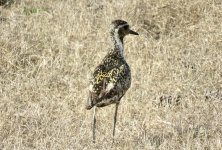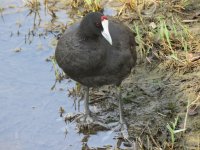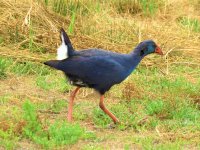Phil Akers
Well-known member

That surprises me Stew with the length of the rear claw?Phil, I
Phil, I think that your pipit is a Tree Pipit!
Stew

That surprises me Stew with the length of the rear claw?Phil, I
Phil, I think that your pipit is a Tree Pipit!
Stew
I believe the length of the claw is within its limits for Tree pipit.That surprises me Stew with the length of the rear claw?
We’ll, it does look quite a robust bird (I always think meadow pipit looks a bit wimpish), there’s quite a contrast between the yellowish breast and the white belly and it seems more heavily streaked in the centre of the breast and weaker on the flanks (meadow pipit is, I think, more uniformly streaked). I’ve just checked Collins and it suggests that the hind claw of tree pipit is curved, which this does seem to be.That surprises me Stew with the length of the rear claw?








Bittern are so hard to see at the best of times, I'd put money on there being more than just two in all those reeds. There's a pair at Oare Marshes in Kent that have only been seen a handful of times, even by the locals.I believe that 2 Great bittern have been seen at s’Albufera in flight.
This is good news as I think in the census, only one was seen.
I can’t understand why there are not more of this species on the Island but I do remember hearing Bittern booming here in the 1980’s.
I have still never seen one but I live in hope.
The Pacific golden plover may have moved on but I would be grateful to hear of any sightings.
Thanks, and good birding everyone.
Mike

Hi Michael. As you know I have had success with Great Bittern at the Albufera over the years. In almost every year I have visited I have seen at least one, on one occasion in 2002 I had 4 together in flight. This May I had 1 only. In 1993 whilst staying at the Habitat Apartment in Puerto Pollensa, one came in early evening from over the Cala San Vicente ridge, dropped down to the garden pool and promptly roosted the night there. Bitterns are an awesome bird and the Albufera is probably the most reliable site to see them... I suspect there are at least several pairs in the marshes.Bittern are so hard to see at the best of times, I'd put money on there being more than just two in all those reeds. There's a pair at Oare Marshes in Kent that have only been seen a handful of times, even by the locals.

The spotless raised a small family there this year which is a good record for the north (my previous sightings have all been from the south mainly around Ses Sallines).With some non-birding things on today’s agenda, and poor weather forecast for this afternoon I made the most of a free couple of hours and headed for Ca’n Cuarassa.
A walk via the two screened pools was unproductive, except that I could hear a bee eater calling. Looking up, I saw a group of six swifts drifting around with a bee eater among them! The birds soon headed off inland.
From the main track I could see two more bee eaters on the telegraph wires to the east, and later I could hear (but not see) more heading south overhead. More evidence of movement was in the shape of groups of swallows (including a group of 40+) heading through continuously.
An osprey flew through heading east, stone curlews were calling from the orchards towards the end of the main track and there was a lot of thekla lark activity around the gardens and open areas to the west.
At Pins16 a bare tree at the back of the plot was being used as a drying station by starlings which were bathing in an unseen pool. A maximum of nine birds were on view, and ‘scope views revealed that both species were present. I could see two adult spotless, there were four or five juvenile common starlings and one or two adult common. I can’t recall seeing mixed flocks before.
Stew
Yes, they bred there last year too - seemingly moving from their previous site at the Club del Sol.The spotless raised a small family there this year which is a good record for the north (my previous sightings have all been from the south mainly around Ses Sallines).















